|
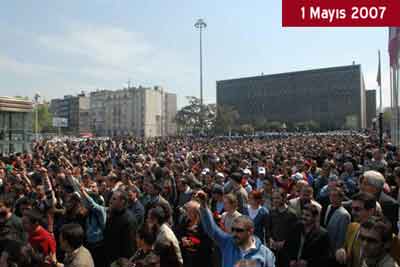
On the 30th anniversary of the Massacre of Mayday 1977, workers and labourers conquered Taksim Square despite that almost an emergency state was announced at the streets of Istanbul, that an intense terror was launched by the state and that the police attacked the actions with gas bombs and plastic bullets. On Mayday 1977, a counter-guerrilla bombing was carried out against the 500 thousand workers and labourers who had gathered in Taksim and 36 workers were killed. Since that time, Taksim is one of the forbidden squares of Turkey and N. Kurdistan.
DISK (one of the two biggest workers' unions confederations), KESK (confederation of the public employers' unions), TMMOB (chamber of the architects and the engineers), TTB (chamber of the doctors), democratic mass organisations, revolutionary and socialist organisations marched towards Taksim despite all the threats of the state and the Governor of Istanbul. 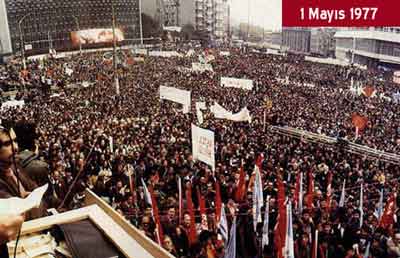
State terror was answered with resistence
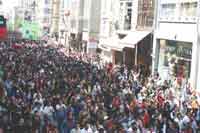 Governor of Istanbul had announced weeks ago that they would not permit a massive Mayday celebration in Taksim. Seeing that the will for Taksim still continues, the Governor tried to hinder a massive participation at the Mayday celebration by cancelling the most important part of the boat trips between the Anatolian and European parts, by limiting the traffic with only one lane. This atmosphere of emergency state, which was created under the pretext of security, paralysed the traffic. All the people of Istanbul, including those who were just going to the school or work, were affected by this. They were stuck in the streets for many hours and they tried to reach their homes by foot. Governor of Istanbul had announced weeks ago that they would not permit a massive Mayday celebration in Taksim. Seeing that the will for Taksim still continues, the Governor tried to hinder a massive participation at the Mayday celebration by cancelling the most important part of the boat trips between the Anatolian and European parts, by limiting the traffic with only one lane. This atmosphere of emergency state, which was created under the pretext of security, paralysed the traffic. All the people of Istanbul, including those who were just going to the school or work, were affected by this. They were stuck in the streets for many hours and they tried to reach their homes by foot.
3500 policemen were sent from the other cities to Istanbul for the demonstration in Taksim. All the streets going to Taksim were full of police check-points. Taksim Square was taken under a police occupation. Sharpshooters were located on the tops of the high buildings. The vehicles of different TV channels were seized and taken to Kasimpasa Bus Station. 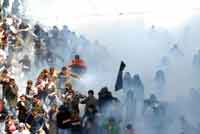 3 thousand labourers who gathered in the district 1 Mayis-Umraniye in order to go to Taksim were not allowed to get out of the district. Those who had gathered in the district Okmeydani were attacked by the police with gas bombs; the conflicts continued for a few hours. The busses coming from different cities to Mayday celebration in Taksim were stopped at the gates of Istanbul in the morning and were ordered to go back. The ferry-boat carrying the workers and labourers coming from Izmir were not allowed to land and were forced to stay on the sea together with the other passenger inside. 3 thousand labourers who gathered in the district 1 Mayis-Umraniye in order to go to Taksim were not allowed to get out of the district. Those who had gathered in the district Okmeydani were attacked by the police with gas bombs; the conflicts continued for a few hours. The busses coming from different cities to Mayday celebration in Taksim were stopped at the gates of Istanbul in the morning and were ordered to go back. The ferry-boat carrying the workers and labourers coming from Izmir were not allowed to land and were forced to stay on the sea together with the other passenger inside.
The Organising Committee for the demonstration consisting of 25 people were taken under custody early in the morning. After this, the police attacked many times different groups which gathered in Besiktas, Dolapdere, Tarlabasi and all the regions around Taksim.
"Everywhere is Taksim; long live Mayday!"
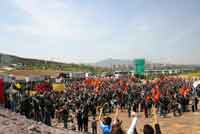 But tens of thousands of workers and labourers, who were full of determination to conquer the prohibited Taksim Square on the 30th anniversary of the Massacre of 1977 in order to ask account from the counter-guerrilla state, achieved to do that despite all. Each attack of the police was answered with resistance. But tens of thousands of workers and labourers, who were full of determination to conquer the prohibited Taksim Square on the 30th anniversary of the Massacre of 1977 in order to ask account from the counter-guerrilla state, achieved to do that despite all. Each attack of the police was answered with resistance.
The workers whose busses were stopped at the gates of the city and the labourers who were who were stuck in their district started the Mayday actions wherever they met the police barricades.
When the busses coming from the other cities were stopped at the Opet Station in Kurtkoy at the Anatolian side of Istanbul, 2 thousand labourers cut the highway TEM and started a march by shouting slogans. They resisted against the attack of the gendarmerie who were throwing plastic bullets. During the attacks on the busses, even gas bombs were thrown inside the vehicles. Many labourers have been injured.
In Okmeydani, the quarter 1st May and other labourers' districts, the police barricades were tried to destroy with Molotov cocktails, stones and sticks.
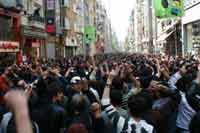 A ferry boat coming from Izmir, was stopped next to Yalova, and the 2 thousand workers on board shouted the slogans "The collaborator governor is afraid of the workers", "The repression can't stop us" and "By continuing with our resistance, we will win". A ferry boat coming from Izmir, was stopped next to Yalova, and the 2 thousand workers on board shouted the slogans "The collaborator governor is afraid of the workers", "The repression can't stop us" and "By continuing with our resistance, we will win".
Every place in Istanbul was the place of celebrating Mayday, on the streets the slogan "everywhere Taksim, long live Mayday" was shouted everywhere.
Following the police attack in the morning, when the organization committee was completely arrested and shouted the slogans "Long live Mayday" and "Shoulder to shoulder against fascism", a second organization committee came together. From 11am on nearly 500 workers started to march from Dolmabahce to Taksim again. The police, who was not able to drift the mass away despite using water cannons, made again use of gas bombs. However, the mass gathered again and within short time, the number of gathering people rose up to 1000 and they reached Taksim. There was a commemoration ceremony at 12am at the place, where the massacre on Mayday in 1977 had happened. The crowd also demanded the immediate release of the arrested workers. The mass shouted the slogans "This is Mayday, this is Taksim" and "Governor resign!".
10thousand workers, who came together on Istiklal Street leading to Taksim Square, had to face police barricades and gas bomb attacks when they entered the Square.
Istiklal Street was turned into gas chambers of Nazi fascism. For a long time, clashes did not stop on the routes around Taksim, such as Tarlabasi, Sishane and Gümüssuyu.
695 labourers under arrest: "Governor resign!"
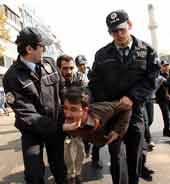 Due to public information, at least 695 people have been arrested in the police attacks on the will of celebrating Mayday in Taksim. Among those arrested are Musa Cam, president of the Mayday Committee of DISK and general secretary of DISK; and the following people who are all members of the organization committee of Mayday: Abdurrahman Daşdemir, general secretary of KESK; Sevgi Gögce, member of the AC of KESK; Ali Riza Kücükosmanoglu, president of the trade union Nakliyat-Is ; Arzu Cerkezoglu, general secretary of the trade union Dec Saglik-Is; Alper Tas, leader of ÖDP of Istanbul; Hüseyin Yesil, member of the AC of TMMOB; Hatice Aydemir, representative of the Socialist Platform of the Oppressed ( ESP ) and representatives of other mass organizations. Due to public information, at least 695 people have been arrested in the police attacks on the will of celebrating Mayday in Taksim. Among those arrested are Musa Cam, president of the Mayday Committee of DISK and general secretary of DISK; and the following people who are all members of the organization committee of Mayday: Abdurrahman Daşdemir, general secretary of KESK; Sevgi Gögce, member of the AC of KESK; Ali Riza Kücükosmanoglu, president of the trade union Nakliyat-Is ; Arzu Cerkezoglu, general secretary of the trade union Dec Saglik-Is; Alper Tas, leader of ÖDP of Istanbul; Hüseyin Yesil, member of the AC of TMMOB; Hatice Aydemir, representative of the Socialist Platform of the Oppressed ( ESP ) and representatives of other mass organizations.
The police also raided th main building of TMMOb, which is located at Taksim, by breaking doors and threw gas bombs on the 200 people, who were inside.
Journalists, too, were affected by the attacks: With the aim to protest against the attacks, they gathered at Taksim Square and declared to give up shooting on that day.
After the attacks, the trade unions DISK and KESK, the party DTP , TMMOB, ESP and other mass organizations organized press statements in which they demanded the resignation of Muammer Güler, the governor of Istanbul.
Dead rally in Istanbul-Kadiköy
Türk-Is, the second of the two biggest trade-unions, organised a separate Mayday celebration in Kadiköy, in accordance to the state's desires, by splitting the workers on Mayday against the determined stance of DISK, KESK and the other mass organizations. Only 5000 people joined this dead rally. Whilst all progressive, democratical and socialist organisations criticised and isolated this sectarian step of Türk-Is, the party EMEP draw all attention on it when claiming that "the discussions on Taksim splitted the working class" and joined the rally in Kadiköy.
When Salih Kilic, president of Türk-is, tried to hold a speech, he was hooted down by the workers with the slogans "Servant of the capital, Salih Kilic", "We don't want a president who is so cheap" and "Türk-Is, do not sleep, look after your workers". Kilic could hardly finish his speech.
Mayday was celebrated from Antep to Izmir, Mersin to Ankara, in many cities with different event. However in Amed (Diyarbakir), as the Mayday celebration was forbidden, workers and labourers came together to organize a mass press release.
|
